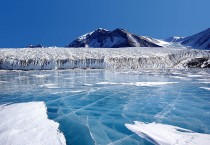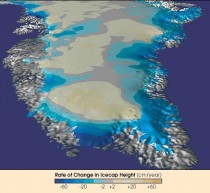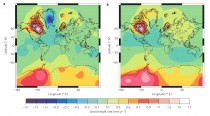UPDATE: In a program “Green Swindle” devoted to exposing the roots of the global warming scandal, Sean Hannity featured many climate skeptics on his Fox News program - part 1 here, part 2 here. 500,000 to some estimate as many as 2 million descended on Washington, D.C. for the 8-28-10 Restoring Honor Rally, CSPAN televised the event.

The event was streamed live via Facebook. It was a very uplifting event. Beck like Hannity have shown how the global warming issue is a fraud and how it evolved and who are involved. There was no politics at the rally though. It was all restoring traditional American values and pride in our heritage.
------------
Ice Sheet Loss Cut in Half
By Doug Hoffman
Much concern has been raised by climate scientists regarding ice loss from the world’s two remaining continental ice sheets. Rapid loss of ice-mass from the glaciers of Greenland and Antarctica are cited as proof positive of global warming’s onslaught. The latest measurements involve the use of satellite gravimetry, estimating the mass of terrain beneath by detecting slight changes in gravity as a satellite passes overhead. But gravity measurements of ice-mass loss are complicated by glacial isostatic adjustments - compensation for the rise or fall of the underlying crustal material. A new article in Nature Geoscience describes an innovative approach employed to derive ice-mass changes from GRACE data. The report suggests significantly smaller overall ice-mass losses than previous estimates.
The storage of water or ice on land - the presence of large bodies of water or glacial ice sheets - affect the Earth’s gravitational field. This effect is detected by the NASA Gravity Recovery and Climate Experiment (GRACE) satellites. Twin satellites were launched in March 2002, to make detailed measurements of Earth’s gravity field. Since then, GRACE has been used to study tectonic features, estimate ground water volumes and calculate the amount of ice contained in the Greenland and Antarctica ice sheets. However, other factors can contribute to the GRACE measurements than just the volume of ice in an ice sheet. These factors include the response of Earth’s crust (the lithosphere) to past changes in ice load.

Antarctica was found to be rising, but not as fast as previously thought.
As the weight of covering ice varies, the underlying surface rock can be pushed down or rise up, buoyed by the magma that the crust floats on. This would obviously impact efforts to measure the height of terrain, including glaciers. Compensating for the rise and fall of bedrock is termed glacial isostatic adjustment, and it can have a significant impact on estimated ice-mass losses. Changes in the spatial distribution of the atmospheric and oceanic masses can also enter into the picture. Correctly assessing these different factors is the key to accurately calculating ice-sheet mass balance. Xiaoping Wu and colleagues have proposed a new method for untangling these factors from GRACE measurements. In a News and Views commentary on the work by Wu et al., David H. Bromwich and Julien P. Nicolas sum up the problem:
The atmospheric and oceanic contributions are commonly derived from global reanalyses or other global climate models that assimilate observations. However, the contribution from glacial isostatic adjustment is more difficult to evaluate because the Earth’s mantle is viscoelastic and therefore responds to changes in surface loading with a long delay. Indeed, the variations of the mass and extent of the ice sheets since the Last Glacial Maximum, about 20,000 years ago, continue to affect present-day changes in bedrock elevation. Assessments of the glacial isostatic adjustment typically rely on deglaciation models - which simulate the evolution of the ice sheets since the Last Glacial Maximum - together with assumptions about the viscosity profile of the mantle. Much is still unknown regarding the history of the ice sheets, and even less is known about the behaviour of the mantle in response to loading and unloading.
The method used by Wu et al., in “Simultaneous estimation of global present-day water transport and glacial isostatic adjustment,” estimates ice-mass changes and glacial isostatic adjustment simultaneously, instead of estimating the latter separately from deglaciation models as had been done before. The problem is expressed in terms of a single matrix equation, with the observed surface-height changes decomposed into their different contributions. The equation is then solved for ice-mass changes using matrix inversion. While the glacial isostatic adjustment that results is not directly generated by deglaciation models, the inversion method still requires a first-guess estimate to begin the calculations.

Ice loss in Greenland has been significantly overestimated.
In describing their work, Wu et al. state: “Here we combine gravity measurements and geodetic data of surface movement with a data-assimilating model of ocean bottom pressure to simultaneously estimate present-day water transport and glacial isostatic adjustment. We determine their separate contributions to movements in the geocentre, which occur in response to changes in the Earth’s mass distribution, with uncertainties below 0.1 mm yr−1.” They further describe their methodology as follows:
From April 2002 to December 2008, linear trends are derived from GRACE gravity data with empirically calibrated full covariance matrices, and from the Jet Propulsion Laboratory’s data-assimilating ocean bottom pressure (OBP) model. These are combined with three-dimensional surface velocities at 664 globally distributed sites. Although the durations of the surface geodetic time series are diverse, most of the data are collected by the global positioning system (GPS) technique during the 2000s and processed up to August 2007. Spherical harmonic coefficients of both PDMT and GIA signatures as well as other relevant parameters are then estimated from the data combination.
Here PDMT stands for present-day surface mass trend and GIA for glacial isostatic adjustment. Those interested in the theoretical framework - including the relevant measurement equations, data sets and uncertainty assessment - should look in the Methods section of the paper and the Supplementary Information pdf.
What is really interesting here is the resulting trend data for the change of bedrock height - the geoid height trend. The new method found that estimates used in the past were significantly in error. Antarctica was found to be rising, but not at as fast a rate as previously thought. Greenland, on the other hand, is actually sinking, particularly in the center of the ice sheet. Previous change estimates had Greenland rising everywhere.
“The negative GIA geoid trend in Greenland could be new evidence for additional net past ice accumulation (-100–300 m of ice depending on rheological properties and onset time) in comparison with the a priori model,”
the researchers state, noting that past accumulation over certain parts of Greenland has been suggested before by other models. The study results can be seen in the figure below, taken from the report.

Unfiltered GIA geoid height trends.
In the figure a, shows rates estimated in the study, and b,those predicted by the ICE-5G/IJ05/VM2 model. While Wu et al. report that both Greenland and Antarctica are loosing ice-mass, they are doing so at a much lower rate than previous estimates and that both are gaining ice in their interiors. “The mass loss in Greenland is concentrated along the coastal areas, and is particularly heavy in the west, and in the southeast with the large Kangerdlugssuaq and Helheim glaciers,” they state. “In contrast, the interior of Greenland shows significant positive mass balance.”
Bottom line on the new work is that ice-mass loss has been overestimated by previous studies. “These findings confirm the ongoing shrinkage of the polar ice sheets,” state Bromwich and Nicolas. “However, and most importantly, the newly estimated ice-sheet mass losses represent less than half of other recent GRACE-based estimates for the same time interval: -230 +/- 33 Gt yr-1 for Greenland2 and -132 +/- 26 Gt yr-1 for West Antarctica.” According to Wu et al. “We conclude that a significant revision of the present estimates of glacial isostatic adjustments and land–ocean water exchange is required.” Perhaps this technique could be applied to the previous GRACE results for Himalayan glaciers as well.
So, when the more exact measurement separation methodology of Wu et al. is applied to the GRACE geoid data, ice sheet shrinkage, which has been systematically overestimated, is cut in half. “The differences between the work by Wu and colleagues and earlier studies may reflect errors in present deglaciation models with respect to the ice-load history and response of the Earth’s mantle,” conclude Bromwich and Nicolas. According to Wu et al.
“significant revision” is required. The general result - the Greenland and Antarctica ice sheets will be with us for a long time to come. See post here.
See Al Gore’s take on this based on the Liu and Curry 2010 model here that predicts future loss. See Bob Tisdale’s analysis here.




